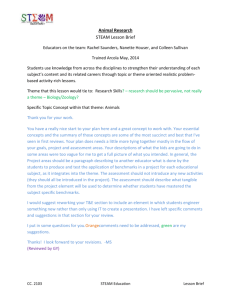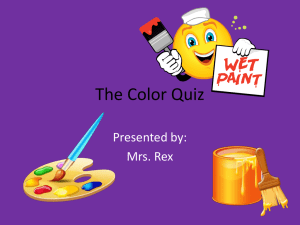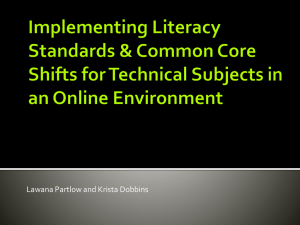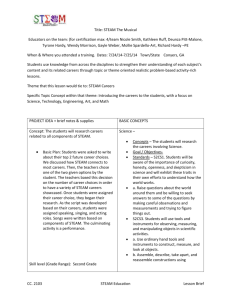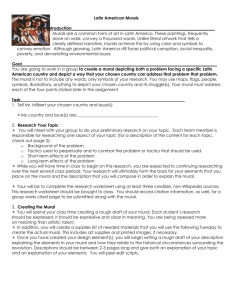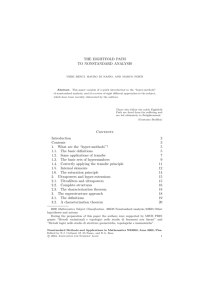5b01e20b29c00ccde2b9fbe1b3eed511
advertisement
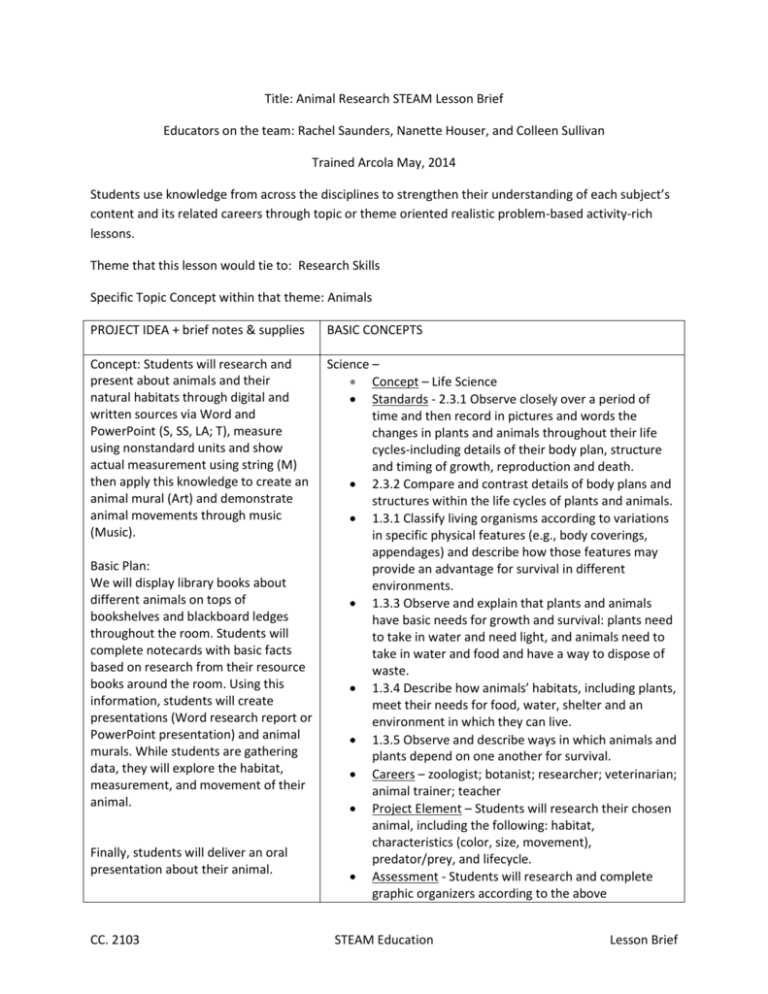
Title: Animal Research STEAM Lesson Brief Educators on the team: Rachel Saunders, Nanette Houser, and Colleen Sullivan Trained Arcola May, 2014 Students use knowledge from across the disciplines to strengthen their understanding of each subject’s content and its related careers through topic or theme oriented realistic problem-based activity-rich lessons. Theme that this lesson would tie to: Research Skills Specific Topic Concept within that theme: Animals PROJECT IDEA + brief notes & supplies BASIC CONCEPTS Concept: Students will research and present about animals and their natural habitats through digital and written sources via Word and PowerPoint (S, SS, LA; T), measure using nonstandard units and show actual measurement using string (M) then apply this knowledge to create an animal mural (Art) and demonstrate animal movements through music (Music). Science – Concept – Life Science Standards - 2.3.1 Observe closely over a period of time and then record in pictures and words the changes in plants and animals throughout their life cycles-including details of their body plan, structure and timing of growth, reproduction and death. 2.3.2 Compare and contrast details of body plans and structures within the life cycles of plants and animals. 1.3.1 Classify living organisms according to variations in specific physical features (e.g., body coverings, appendages) and describe how those features may provide an advantage for survival in different environments. 1.3.3 Observe and explain that plants and animals have basic needs for growth and survival: plants need to take in water and need light, and animals need to take in water and food and have a way to dispose of waste. 1.3.4 Describe how animals’ habitats, including plants, meet their needs for food, water, shelter and an environment in which they can live. 1.3.5 Observe and describe ways in which animals and plants depend on one another for survival. Careers – zoologist; botanist; researcher; veterinarian; animal trainer; teacher Project Element – Students will research their chosen animal, including the following: habitat, characteristics (color, size, movement), predator/prey, and lifecycle. Assessment - Students will research and complete graphic organizers according to the above Basic Plan: We will display library books about different animals on tops of bookshelves and blackboard ledges throughout the room. Students will complete notecards with basic facts based on research from their resource books around the room. Using this information, students will create presentations (Word research report or PowerPoint presentation) and animal murals. While students are gathering data, they will explore the habitat, measurement, and movement of their animal. Finally, students will deliver an oral presentation about their animal. CC. 2103 STEAM Education Lesson Brief Students’ notecards and presentation will be assessed using anecdotal notes. Their animal mural will be evaluated on color schemes, size relativity, and standard/nonstandard measurement. All other subject areas will be assessed informally. Skill level (Grade Range): 1st- 2nd grade Timing of Lesson: Math: 2 periods, 30 minutes each Social Studies: 5 periods, 30 minutes each over the course of 3 weeks Science/Engineering: 5 periods, 30 minutes each over the course of 3 weeks Language/Technology: 5 periods, 30 minutes each over the course of 3 weeks PE: 1 class periods, 30 minutes total Music: 1 class period, 30 minutes total Art: 4 class periods, 50 minutes each Basic Supplies: All Subjects: Pencil Graphic organizers Individual Subjects: Science: Informational Texts Math: Informational Texts Graph paper String Scissors Measurement Tools (rulers and yardsticks) Nonstandard Tools to Measure (cubes, paperclips, etc.) CC. 2103 requirements. Extension - Students can find additional information regarding their animal to add to their project. Technology– Concept – Research through educational websites and presentation through Word or PowerPoint programs Standards – 2.ML.2.1:Recognize that media can be sources for information, entertainment, persuasion, interpretation of event an transmission of culture. 2.SL.4.2: Create simple presentations that maintain a clear focus, using various media when appropriate to clarify ideas ,thoughts, and feelings. Careers – college professor; researcher; technology specialist; journalist Project Element – Students will analyze websites searching for facts about their animal. Students will create a PowerPoint presentation or Word report. Once students complete the basic tasks, they will use their knowledge to measure/create an artistic representation of their animal. They will then use the nonstandard tools to measure the animal for their painting. Using string and standard measurement tools (ruler, yardstick), they will give an actual-size representation of their animal size. Assessment – Students will provide facts from their secondary source as well as their primary source (informational texts). Students will create digital presentations of their research. Extension - Students may add extra information to their report. Students will develop their own designs (fonts, colors, formatting, graphics) to their presentation. Math – Measurement Concept – Measurement Standards – 2.M.2: Estimate and measure the length of an object by selecting and using appropriate tools, such as rulers, yardsticks, meter sticks, and measuring tapes to the nearest inch, foot, yard, centimeter and meter. 1.M.1: Use direct comparison or a nonstandard unit to compare and order objects according to length, area, capacity, weight, and temperature. Careers – carpenter; builder; construction Project Element – Students will research the average measurements of their adult animal. They will select STEAM Education Lesson Brief Social Studies: Informational Texts Language: Informational Texts Art: Informational Texts White Butcher Paper Paint Scissors Paintbrushes LA – P.E. Body Movements Music CDs with nature sounds IT Resources: Computer Lab Online encyclopedia Research websites Other Resources: Misc: Photos: SS – CC. 2103 the appropriate tool to represent the actual size (length and height) of their animal using string. They will use nonstandard standard units to create a mural of their animal to size relativity. They will tape their accurate string measurements near their animal painting. Assessment – Students will demonstrate accurate measurements of their animal. Extension - Students may compare their measurements to other students’ animals. Concept – Reading Nonfiction Key Ideas and Textual Support; Writing: the Research Process; Presentation of Knowledge and Ideas Standards – 2. W. 5 Conduct short research on a topic. 2.SL.4.2: Create simple presentations that maintain a clear focus, using various media when appropriate to clarify ideas ,thoughts, and feelings. 1.SL.4.2: Add drawings or other visual displays, such as pictures and objects, when sharing information to clarify ideas, thoughts, and feelings. Careers – author; journalist; researcher Project Element 1– Students will preview a plethora of informational text resources, as well as Internet websites, about their animal. Next, students will complete graphic organizers to plan their project (PowerPoint/Word document.) Project Element 2 – Students will present their research project to their peers. Assessment 1 – Through informal assessment, the teacher will evaluate the depth and accuracy of their research information. Assessment 2 - During oral presentations, students will present accurate information in a clear, projected voice. Extension - Students may answer questions from the audience that goes beyond the project expectations. Concept – Geography Standards – 1.3.5 Summarize weather patterns in the community, including temperature, precipitation, cloud cover and the amount of sunlight during the different seasons of the year 1.3.6 Explain the effect of seasonal change on plants, animals, and people STEAM Education Lesson Brief Samples of mural animal: Art – PE – CC. 2103 Careers – geoscientist; meteorologist; surveyor; environmental lawyer; Department of Environmental Inspection Project Element – Students will explore the biome where their animal resides. They will discover the location, landforms, weather, and habitat. Assessment – Students will report the information in their presentation. Extension – The students will compare and contrast the geography of their animal to their peers’. Concept – Visual Arts: Creating Art: Studio Production Standards – 1.6.1 Demonstrate skills of perception in production of artwork. 1.6.4 Demonstrate thoughtfulness and care in creating artwork. 1.6.5 Reflect on and share work with others. 1.6.6 Respect personal work and the work of others. Careers – book illustrator; graphic designer; marketing advertising Project Element – Students will examine illustrations from their research materials. Next, students will create a mural using tempera paint. Assessment – Students will display teamwork to complete their mural of painting their chosen animal. Extension – Students may add extra components of their habitat such as environmental features, prey, etc. Concept – Physical Activity; Motor Skills and Movement Patterns Standards – 1.1.1 Perform locomotor skills with developmentally appropriate challenges to reinforce learning of basic movements. 2.1.1 Perform locomotor skills proficiently and in combinations with developmentally appropriate challenges. Careers – wellness coach; physical therapist; general practitioner Project Element 1 – Students will demonstrate appropriate movements of their animal. Project Element 2 – Students will participate in an animal tag game. The students will wear a tag identifying which animal they represent. In the game, they will “tag” only students who live in their same biome. STEAM Education Lesson Brief Assessment 1 – Students will use what they know about their animal to show how it moves in its natural habitat. Assessment 2 – Students will be able to identify the other animals from their habitat. Extension – Students will learn the movements of other animals in the classroom. Music – Concept – RESPONDING TO MUSIC: Reading, notating, and interpreting music Standards – 1.5.3 Use body percussion and movement to demonstrate rhythmic patterns. Careers – musician; choir director; composer Project Element – Students will listen to nature music indigenous to the animal’s environment. Assessment – Students will use active listening as the music plays and will participate by using appropriate animal movements with their body. Extension – Students will interpret how their animal moves in different environments. CC. 2103 STEAM Education Lesson Brief
